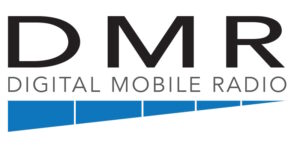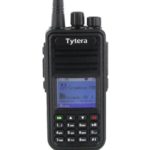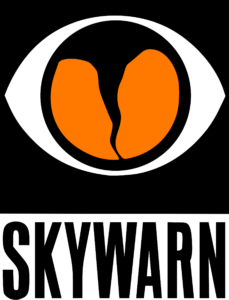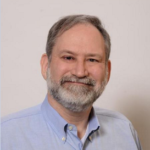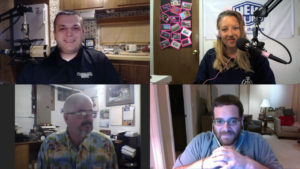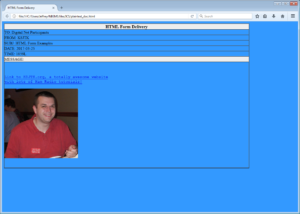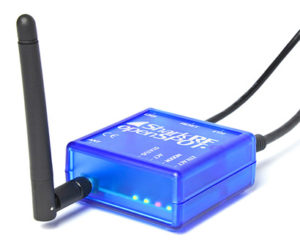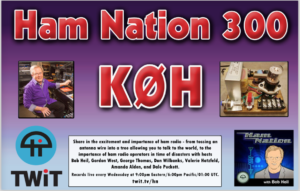One of the responsibilities of the Technical Coordinator in the Ohio Section is to submit something for the Section Journal. The Section Journal covers Amateur Radio related things happening in and around the ARRL Ohio Section. It is published by the Section Manager Scott – N8SY and articles are submitted by cabinet members.
Once my article is published in the Journal, I will also make it available on my site with a link to the published edition.
You can receive the Journal and other Ohio Section news by joining the mailing list Scott has setup. You do not need to be a member of the ARRL, Ohio Section, or even a ham to join the mailing list. Please sign up!
If you are an ARRL member and reside in the Ohio Section, update your mailing preferences to receive Ohio Section news in your inbox. Those residing outside the section will need to use the mailing list link above.
Updating your ARRL profile will deliver news from the section where you reside (if the leadership chooses to use this method).
Go to www.arrl.org and logon.
Click Edit your Profile.
You will be taken to the Edit Your Profile page. On the first tab Edit Info, verify your Email address is correct.
Click the Edit Email Subscriptions tab.
Check the News and information from your Division Director and Section Manager box.
Click Save.
Now without further ado…
Read the full edition at: http://n8sy2.blogspot.com/2017/06/june-edition-of-ohio-section-journal.html
THE TECHNICAL COORDINATOR
Jeff Kopcak – TC
k8jtk@arrl.net
Another Dayton Hamvention is in the books. Yes, despite the arguments – ‘it’s not in Dayton anymore blah blah blah’ – the program guide still says “Dayton Hamvention.”
My dad, N8ETP and I have been attending Hamvention consecutively for the past 3 years. I’ve gone down a couple years by myself, stayed at numerous hotels in the area, bummed rides off friends, taken bus trips, and even stayed at the dorms on the University of Dayton’s campus. Returning back each year quickly brings back memories of routes in and out of the arena along with familiar eating and travel destinations. The layout inside rarely changed. You knew where the prize booth was located along with favorite dealers, vendors, clubs and organizations. The entire back parking lot was the flea market. There was the usual selection of arena eats – burgers, nachos, hot dogs, pizza, and ice cream – that often benefited a local school or community organization.
Now, everything is different.
The Hamvention committee should be commended for the monumental task of moving the event from the now closed Hara Arena to the Greene County Fair Grounds in Xenia, Ohio within 9 months. I can’t even imagine what it takes to setup an event that draws 25-30,000 people let alone move it to another location quickly.
Buildings at the new location are less than 20 years old. They were rebuilt after a tornado hit the fairgrounds in 2000. RV parking and an on-site bathhouse were available. There was ample parking on the grounds and at three remote locations with shuttle transportation. Quite different compared to the dilapidated arena where there always seemed to be a haze indoors due to the lack of air flow, falling ceiling tiles with mold and probably 30-year-old dust, and septic system with a propensity to explode.
Atmosphere of was more “fair” than “convention” because vendors and exhibitors were spread out over separated buildings (themed Maxim, Tesla, Marconi, and Hertz), displays were in outside tents, 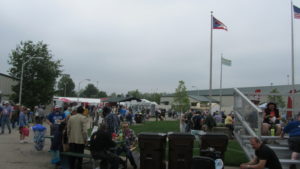 and an abundance of food trucks and carts similar to that of any county fair was seen. More eating area was needed compared to the amount we were used to at Hara. There were long lines and the limited seating, for maybe 50, filled quickly. I had an enjoyable standing lunch with members of the Wood County ARC.
and an abundance of food trucks and carts similar to that of any county fair was seen. More eating area was needed compared to the amount we were used to at Hara. There were long lines and the limited seating, for maybe 50, filled quickly. I had an enjoyable standing lunch with members of the Wood County ARC.
If you were lucky enough to be there Friday, you were greeted by the “Welcome to Xenia” signs quickly followed by break lights and miles of cars waiting to get into the fairgrounds. Even the shuttles were stuck in traffic. The reason was discovered once we arrived. Cars were being parked at a rate of nearly one-at-a-time. Time was wasted waiting to see which isles were full and which ones had room for additional cars. This was quickly remedied Saturday as cars were being parked in multiple locations at once, effectively eliminating the traffic issue from Friday. Scratch that issue off the list.
In general, Hamvention is smaller. I knew this going in from vendors indicating they weren’t going to have the space they were used to. Vendors made the most of it and generally seemed to work. As a result, vendors couldn’t bring the usual amount of stock. Show specials for things like the very popular TYT MD-380, you could purchase one but couldn’t leave with one. In one case, it would be shipped and arrive the following Tuesday. Kinda a bummer as many hoped to leave with a new toy. Vendors in the outside display tent got washed out with storms that rolled through. Not good for computers, sensitive radio equipment, and video cameras I saw out there. I was not able to find Mendelsons – a long time staple of the Hara flea market. I heard others asking too if they had been spotted.
Lastly, mud. The flea market and parking lots were in grassy areas, or at least started out that way. Friday wasn’t bad as the ground was soft in a few areas of the flea market. Saturday morning, with the help of overnight storms, large farm tractors used for transporting patrons were contributing to the problem of turning the grassy 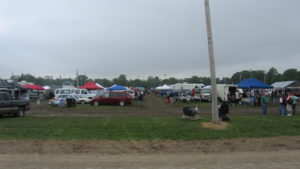 parking lot into a mud pit. After everyone took shelter for even more storms Saturday morning, allll bets were off. The flea market isles were mud tracks. A good pair of rain boots were needed to help manage. It was funny watching rented scooters trying to manage a couple inches of mud. Not wanting to get our clothes dirty, we headed out about 3pm on Saturday and learned the parking lot suffered the same fate as the flea market. The committee, I think, anticipated this because they had rope and skid loaders for cars that needed assistance. We exited without assistance but still need to get our car washed twice to get MOST of the mud off.
parking lot into a mud pit. After everyone took shelter for even more storms Saturday morning, allll bets were off. The flea market isles were mud tracks. A good pair of rain boots were needed to help manage. It was funny watching rented scooters trying to manage a couple inches of mud. Not wanting to get our clothes dirty, we headed out about 3pm on Saturday and learned the parking lot suffered the same fate as the flea market. The committee, I think, anticipated this because they had rope and skid loaders for cars that needed assistance. We exited without assistance but still need to get our car washed twice to get MOST of the mud off.
All-in-all, I’ll call it a success. Out of the things that could go wrong, these issues were the harder ones to plan and tackle. The traffic issue was resolved the next day. This shows they are already learning from the problems that came up during the show. It was a suitable location for a venue change in 9 months. Anyone who is thinking of going next year, you should make your reservations now. The camaraderie, meet and greets, and running into fellow hams was as exciting as ever. If any of the planning committee is reading, I have an idea for a bigger location… just sayin’.
If you didn’t catch the June 7th episode of Ham Nation, Michael Kalter – W8CI was the featured guest for the Hamvention recap. They talked issues and plans for the future. If you think they’re only working on minor changes, you’d be wrong. More: https://twit.tv/shows/ham-nation/episodes/303
There wasn’t a ton of major announcements at Hamvention. Some of the more technical things I did pick up on:
- ICOM had a prototype of their latest direct-sampling SDR transceiver, the IC-7610. It resembles the IC-7600 with the SDR features of the IC-7300. They’re looking at late summer availability once approved by the FCC.
- Kenwood featured their TH-D74 APRS & D-STAR 144/220/430 HT. This radio has been out for some time but were touting D-STAR has seen a resurgence because of this radio. I don’t think people are going to start putting up D-STAR repeaters again because of one radio. Kenwood is looking for feedback from customers to see if there is interest creating an equivalent mobile radio to the D74.
- 220 MHz DV access point (DVAP) for the D74 and 4 new “DV AIR” devices by Robin AA4RC. AIR series are embedded devices supporting the DV Dongle, DV3K, and DVAP eliminating the configuration and need of a Raspberry Pi to make those devices portable.
- Yaesu had their new DR-2X repeater on display.
- Flex Radio has four new SDR radios. Two models integrate the Maestro control panel (touch screen and controls) into the radio. If you ever thought ‘real radios have knobs,’ there you go.
- Just before Dayton, Connect Systems shipped the first batch of CS800D DMR dual band mobile radios. There is a waiting list for the next around assuming no issues with the first. Check the Connect Systems store and look for the ‘CS800D waiting list’ option for instructions.
The 300th episode of Ham Nation was the week before Dayton. I attended the Ham Nation forum which was still standing room only 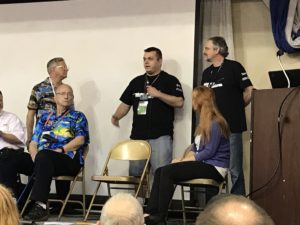 in the new room. I got to be apart of the forum promoting the D-STAR After Show net. Show hosts and net controllers were invited to the ARRL booth afterward to get our picture taken with Tom Gallagher – NY2RF.
in the new room. I got to be apart of the forum promoting the D-STAR After Show net. Show hosts and net controllers were invited to the ARRL booth afterward to get our picture taken with Tom Gallagher – NY2RF.
With the highlights and festivities around Dayton Hamvention, the special event commemorating 300 episodes of Ham Nation kicked 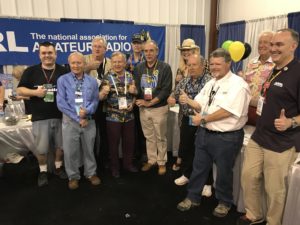 off the following Wednesday with episode 301. For one week, show hosts, after show net controllers, many with 1 x 1 special event call signs where on the HF bands and digital modes. With nearly an estimated 10,000 contacts made, digital didn’t get the numbers we hoped. There were pileups for the nets but quickly dropped off for the remainder of the week. The idea for digital was to involve more hams that don’t have privileges or means for an HF setup. Those that participated were happy digital was involved.
off the following Wednesday with episode 301. For one week, show hosts, after show net controllers, many with 1 x 1 special event call signs where on the HF bands and digital modes. With nearly an estimated 10,000 contacts made, digital didn’t get the numbers we hoped. There were pileups for the nets but quickly dropped off for the remainder of the week. The idea for digital was to involve more hams that don’t have privileges or means for an HF setup. Those that participated were happy digital was involved.
If you participated in Ham Nation 300, send your QSL card with an SASE to the stations worked. A commemorative card will be returned. The logs are being compiled for the certificates which will be available in the future, catch the show for details. Lastly, the points challenge is going on until August so you still have time to get involved if you missed the special event stations.
Last month, I started out with an introductory series on terminology used in ham radio DMR. I finished a second writeup on programming a code plug from scratch. Programming is focused around the TYT MD-380 but should apply to other CPSes too. It covers a fictitious repeater example, hotspot configuration (even for the DV4Mini), and simplex operation. Check it out and get familiar with your DMR radio by programming it! http://www.k8jtk.org/2017/06/11/dmr-in-amateur-radio-programming-a-code-plug/
Not at Dayton but shortly after, I saw a hands-on review of the new Tytera (TYT) MD-2017 DMR dual band hand held on Ham Radio 2.0. You heard right, a DUAL BAND DMR HT! I was excited for this radio 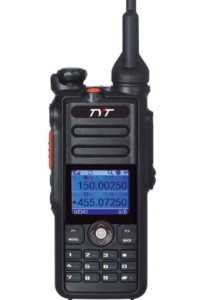 even though there are not many VHF DMR repeaters – unless you’re in New England it seems. The review indicated the channel selector knob was replaced with a Blackberry Curve-style roller trackball. My enthusiasm quickly deflated. WHY??!! I had a BB Curve. The trackball was a nice idea at the time but it was overly sensitive, got gummed up quickly – especially in a dirty environment, was hard to clean, and had to be replaced about once a year. The radio itself is similar to the MD-380 but differences include programming cable, software, code plugs, and a VFO. An MD-380 code plug won’t open in the MD-2017 CPS. I’m sure a hacked program will be available to load code plugs on different radios. Seemed like a good radio otherwise, though I won’t be getting one. Ham Radio 2.0 Episode 99: Debut of the TYT MD-2017 Dual Band DMR HT: http://www.livefromthehamshack.tv/2017/05/29/episode-99-debut-tyt-md-2017-dual-band-dmr-ht/
even though there are not many VHF DMR repeaters – unless you’re in New England it seems. The review indicated the channel selector knob was replaced with a Blackberry Curve-style roller trackball. My enthusiasm quickly deflated. WHY??!! I had a BB Curve. The trackball was a nice idea at the time but it was overly sensitive, got gummed up quickly – especially in a dirty environment, was hard to clean, and had to be replaced about once a year. The radio itself is similar to the MD-380 but differences include programming cable, software, code plugs, and a VFO. An MD-380 code plug won’t open in the MD-2017 CPS. I’m sure a hacked program will be available to load code plugs on different radios. Seemed like a good radio otherwise, though I won’t be getting one. Ham Radio 2.0 Episode 99: Debut of the TYT MD-2017 Dual Band DMR HT: http://www.livefromthehamshack.tv/2017/05/29/episode-99-debut-tyt-md-2017-dual-band-dmr-ht/
The next big ham holiday, Field Day, is right around the corner. Get out and join your club or find a club to join if you’re not a member of one. It’s a great time to bring friends and get them excited about ham radio. Hams that come out get bitten by the bug to expand their station or learn a new mode. Check the Field Day Locator for operations taking place near you: http://www.arrl.org/field-day-locator. Sending 10 messages over RF from your site gets you 100  points – including Winlink messages. I love to receive messages about your setup, stations operating, or social activities taking place. These can be sent via the National Traffic System (NTS) or Winlink – K8JTK at Winlink.org. Winlink post: https://winlink.org/content/field_day_send_11_winlink_messages_200_points
points – including Winlink messages. I love to receive messages about your setup, stations operating, or social activities taking place. These can be sent via the National Traffic System (NTS) or Winlink – K8JTK at Winlink.org. Winlink post: https://winlink.org/content/field_day_send_11_winlink_messages_200_points
With July around the corner, the 13 Colonies special event is coming up (http://www.13colonies.net/) along with the RAC Canada Day contest (http://wp.rac.ca/rac-canada-day-contest-rules-2017/).
Note: Ham Nation pictures taken by Tom – N8ETP.
Thanks for reading and 73… de Jeff – K8JTK

